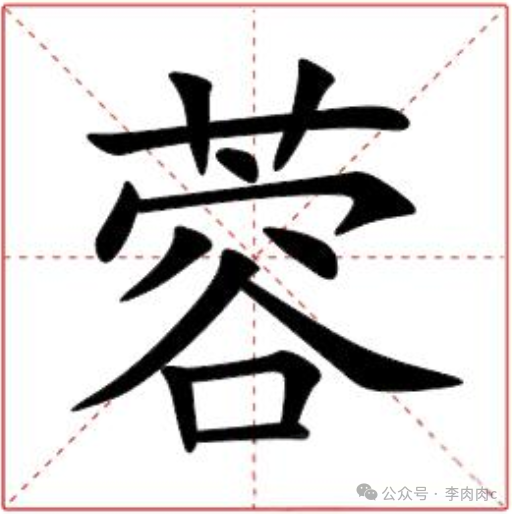
In the “Can Tong Qi”, it is stated: “Rou Cong Rong can replenish essence and strengthen Yang.” In “Dream of the Red Chamber”, Jia Mu also rewarded this precious traditional Chinese medicine, but Jia Zheng and Wang Fu Ren mistakenly pronounced “Cong Rong” as “cóng róng”, which made Jia Mu laugh.
Did you know? 90% of people mispronounce the character “Cong”! This raises the question: how should this character be pronounced? Why do so many people mispronounce it?
The correct pronunciation of this character is cōng, first tone, pronounced like “scallion”. Who would have thought that this seemingly complex character is pronounced this way, it really is a surprise!
A simple way to remember it is: “Rou Cong Rong” is a precious traditional Chinese medicine that grows in the desert, emerging from the sand like a large scallion, so the character “Cong” is pronounced “cōng” (葱).
The structure of the character “Cong” is an upper and lower structure, with the top being “艹” (grass radical), indicating a plant; the bottom is “匆”, indicating sound.
In simple terms, “Cong” is a combination of “grass radical” and “匆”, indicating a type of herbaceous plant.
Why is the character “Cong” often mispronounced?
The most common mispronunciation is “cóng”, mainly because many people confuse “Cong” with “Cóng”. The character “Cóng” is commonly used and simple, while “Cong” is rare and complex, leading people to subconsciously replace the unfamiliar pronunciation with a familiar one.
The characteristics of Chinese characters as phonetic compounds also contribute to the mispronunciation. The lower part of the character “Cong” is “匆”, but “匆” (cōng) and “从” (cóng) have similar pronunciations, which can easily cause confusion.
In some regional dialects, the distinction between the first and second tones is not clear, which also leads to pronunciation confusion. Especially in some northern regions, the distinction between “cōng” and “cóng” is not obvious, allowing the incorrect pronunciation to spread.
Interestingly, the character “Cong” was originally explained in the “Shuo Wen Jie Zi” as “Ma Hui Cao”, a type of herbaceous plant that can be used as fodder. However, what we now refer to as “Rou Cong Rong”, scientifically known as the fleshy Cong Rong, is a parasitic plant that grows on the roots of the Salsola, with a fleshy and thick appearance, which is different from the plants originally referred to by the character “Cong”.
Historical changes have led to changes in meaning, but the pronunciation has been passed down.
The Cultural Significance of “Cong” from Ancient to Modern Times
In the Tang Dynasty, Sun Simiao recorded in “Qian Jin Yao Fang”: “Rou Cong Rong, sweet in taste, neutral. It is used for five labors and seven injuries, replenishing the center, eliminating cold from the stem, nourishing the five organs, strengthening Yang, and benefiting essence and energy.” This is the earliest systematic record of the medicinal effects of Rou Cong Rong.
In the Ming Dynasty, Li Shizhen provided a detailed description of Rou Cong Rong in “Bencao Gangmu”: “Rou Cong Rong grows in the desert sand fields, sprouts in March, looks like a fleshy pillar, has no leaves, and is one to two feet tall, purple-red in color.”
In the Qing Dynasty, Cao Xueqin also described it in the fortieth chapter of “Dream of the Red Chamber”: “Jia Mu said: ‘Someone sent me a box of fine Rou Cong Rong the other day, and I forgot. Tomorrow let someone send him a few pounds’…” This vividly showcases the social status of Rou Cong Rong as a precious tonic.
These literary records not only prove the important position of Rou Cong Rong in the history of traditional Chinese medicine but also demonstrate its cultural value throughout history.
In modern life, Rou Cong Rong is known as the “Desert Ginseng”, a precious traditional Chinese medicinal material. It is often used to make tonics and health products, especially popular during winter supplementation.
However, be careful, when discussing traditional Chinese medicinal materials, pronouncing “Cong” correctly (cōng róng) not only avoids the embarrassment of mispronunciation but also showcases your professional knowledge, instantly enhancing your image as a “Traditional Chinese Medicine Expert”!
Become an Expert in One Second: Practical Use of the Character “Cong”
Let’s test if you have really learned:
-
Question: What is the correct pronunciation of “Cong” in the term “Rou Cong Rong”?
-
Answer: cōng, first tone, pronounced like “scallion”.
Next time you hear someone discussing “Rou Cong Rong” and they mispronounce it, you can confidently correct them: “Actually, the character ‘Cong’ is pronounced ‘cōng’, first tone, just like ‘葱’.” This little piece of knowledge is enough to make you stand out in your social circle!
Are there other traditional Chinese medicine names that confuse you? Feel free to leave a comment to discuss!